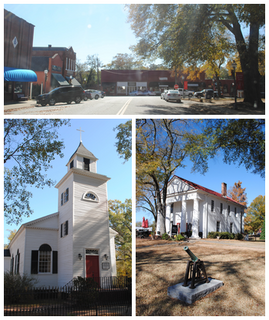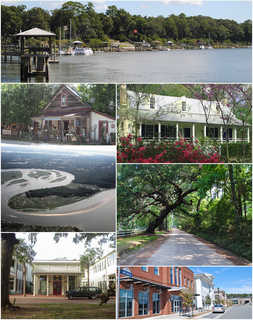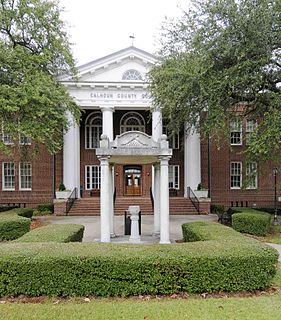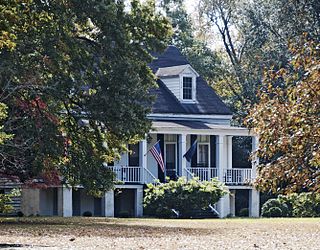
Pendleton is a town in Anderson County, South Carolina, United States. The population was 2,964 at the 2010 census. It is a sister city of Stornoway in the Outer Hebrides of Scotland.

Bluffton is a town in Beaufort County, South Carolina, United States. It is primarily located around U.S. Route 278, between Hilton Head Island and Interstate 95. The Lowcountry town's original one square mile area, now known as Old Town, is situated on a bluff along the May River. The population as of the 2020 census was 27,716, an increase of over 120% since 2010, making it one of the fastest growing municipalities in South Carolina with a population over 2,500. Bluffton is the fifth largest municipality in South Carolina by land area. The town is a primary city within the Hilton Head Island-Bluffton-Beaufort, SC Metropolitan Statistical Area.

Clemson is a city in Pickens and Anderson counties in the U.S. state of South Carolina. Clemson is home to Clemson University; in 2015, the Princeton Review cited the town of Clemson as ranking #1 in the United States for "town-and-gown" relations with its resident university. The population of the city was 13,905 at the 2010 census.
Fort Motte was developed first as Mt. Joseph Plantation; it was commandeered in 1780 by the British and fortified as a temporary military outpost in what is now South Carolina during the American Revolutionary War. It was significant for its military use as a depot for their convoys between Camden and Charleston, which they occupied. Located along the Congaree River, it is roughly 90–95 miles from Charleston by 21st-century roadways. The British had fortified the big house and surrounds, and it became known as Fort Motte, after Rebecca Brewton Motte, who had been occupying it with her family. During the Patriot Siege of Fort Motte, the plantation mansion was set on fire. The British surrendered at this site.
The Cherokee Path was the primary route of English and Scots traders from Charleston to Columbia, South Carolina in Colonial America. It was the way they reached Cherokee towns and territories along the upper Keowee River and its tributaries. In its lower section it was known as the Savannah River. They referred to these towns along the Keowee and Tugaloo rivers as the Lower Towns, in contrast to the Middle Towns in Western North Carolina and the Overhill Towns in present-day southeastern Tennessee west of the Appalachian Mountains.

Stagville Plantation is located in Durham County, North Carolina. With buildings constructed from the late 18th century to the mid-19th century, Stagville was part of one of the largest plantation complexes in the American South. The entire complex was owned by the Bennehan, Mantack and Cameron families; it comprised roughly 30,000 acres (120 km2) and was home to almost 900 enslaved African Americans in 1860.

John Ewing Colhoun was a United States Senator and lawyer from South Carolina.

The 1867 Matheson House is a historic building in Gainesville, Florida, United States. It is located at 528 Southeast 1st Avenue. It was the home of James Douglas Matheson and Augusta Florida Steele Matheson, the daughter of Florida pioneer Augustus Steele, who founded Hillsborough County and Cedar Key. James Douglas Matheson owned a dry goods store in downtown Gainesville and was active in local and state politics, as was his son, eight-term Gainesville mayor Chris Matheson, who was also a state legislator.

Fort Hill, John C Calhoun House and libraries', is a National Historic Landmark on the Clemson University campus in Clemson, South Carolina, United States. The house is significant as the home of John C. Calhoun, the 7th Vice President of the United States, from 1825 to 1850. It is now a house for museums and libraries.
Oakland Plantation may refer to:

The High Hills of Santee, sometimes known as the High Hills of the Santee, is a long, narrow hilly region in the western part of Sumter County, South Carolina. It has been called "one of the state's most famous areas". The High Hills of Santee region lies north of the Santee River and east of the Wateree River, one of the two rivers that join to form the Santee. It extends north almost to the Kershaw county line and northeasterly to include the former summer resort town of Bradford Springs. Since 1902 the town has been included in Lee County.

The Abbeville County Courthouse, built in 1908, is an historic courthouse located in the east corner of Court Square, in the city of Abbeville in Abbeville County, South Carolina. It was designed in the Beaux Arts style by Darlington native William Augustus Edwards who designed several other South Carolina courthouses as well as academic buildings at 12 institutions in Florida, Georgia and South Carolina. An arcade connects it to the adjoining Abbeville Opera House and Municipal Center, which Edwards also designed. In 1964, the courthouse was renovated by Lyles, Bissett, Carlisle, and Wolff of Columbia. On October 30, 1981, it was added to the National Register of Historic Places. It is included in the Abbeville Historic District.

The Calhoun County Courthouse, built in 1913, is a historic courthouse located in the city of St. Matthews in Calhoun County, South Carolina. It was designed in the Colonial Revival style by Darlington native William Augustus Edwards who designed eight other South Carolina courthouses as well as academic buildings at 12 institutions in Florida, Georgia and South Carolina. Calhoun County was created in 1908 and this is its first and only courthouse. It was listed on the National Register of Historic Places in 1981.

This is a list of the National Register of Historic Places listings in Calhoun County, South Carolina.

This is a list of the National Register of Historic Places listings in Jasper County, South Carolina.
Midway Plantation may refer to:

Midway Plantation is a historic plantation house located near Fort Motte, Calhoun County, South Carolina. The original Midway plantation was built about 1785, although little of this structure remains. The present façade was added about 1859, and is a two-story antebellum frame building with both Greek Revival and Federal influences. The front façade features a pediment and a two-tiered portico with four Tuscan order columns on both levels. The rear wing and porch were added around 1900.

Oakland Plantation is a historic plantation house located near Fort Motte, Calhoun County, South Carolina. It was built about 1800, and is a 1+1⁄2-story clapboard house with two flanking wings set back from the façade. The house sits on a brick foundation and has an enclosed basement. It has a front porch, supported by six square columns. Oakland is still surrounded by farmland, and the house and one outbuilding, the original kitchen, are situated on a one-acre lot.

Zante Plantation was a historic plantation house located near Fort Motte, Calhoun County, South Carolina. It was built about 1815, and is a 2+1⁄2-story frame structure with Federal details. It has a stucco-over-brick foundation approximately seven feet high. Both front and rear facades have one-story porches. Several original outbuildings remain on the property. Zante has been the home of several prominent South Carolinians, its history reaching as far back as the late-18th century.

Puritan Farm, also known as Keitt-Whaley-Pearlstine House, is a historic plantation house located near St. Matthews, Calhoun County, South Carolina. It was built between 1820 and 1825, and is a large white two-story clapboard frame I-house. It has a pedimented second floor porch addition, two connecting rear wings, and a full-width front porch with six square columns. The main block of the house is one-room deep with a central hall on each floor. The house was the residence of Congressman Laurence M. Keitt, a leader of the South Carolina secessionist movement. Keitt was born in this house in 1824 and maintained it as his residence until his death in 1864.



















